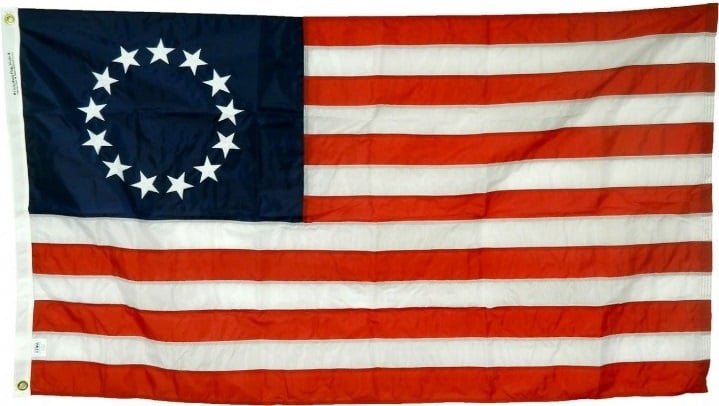History of the Betsy Ross Flag
 Distinguished by its alternating red-and-white stripes and thirteen white stars arranged in a circle on a blue canton, the Betsy Ross Flag is one of the earliest recognized designs of the American flag.
Distinguished by its alternating red-and-white stripes and thirteen white stars arranged in a circle on a blue canton, the Betsy Ross Flag is one of the earliest recognized designs of the American flag.
In use since 1777, the flag is named for Philadelphia upholsterer and flag maker Elizabeth “Betsy” Ross, but its true origins remain up for debate.
A Bit about Betsy
Born Elizabeth Griscom on January 1, 1752 to a Quaker family in Philadelphia, Betsy began her apprenticeship as an upholsterer when she was just 17 years old. There, she met John Ross, a fellow apprentice and Anglican, and a star-crossed love affair began. Marrying outside the Quaker religion was strictly forbidden, but Betsy married John anyway. Expelled from her family and the Quaker Friends meeting house where she worshipped, Betsy pressed on, continuing her skilled needlework and later opening an upholstery business with her husband.
Following John’s death from a gunpowder explosion in 1776, Betsy continued the upholstery business on her own, making flags for Pennsylvania and the American Revolution. According to records, she was paid 14 pounds in 1777 for making “ship colours” for the Pennsylvania State Navy Board.
Betsy remarried and was widowed twice. Her second husband, a sailor named Joseph Ashburn, died in prison after his ship was captured by the British, and her third husband, John Claypoole, died after a long disability. Betsy herself lived to be 84 years old, but her story of the first American Flag wasn’t made public until nearly 50 years after her death.
The Story of the First American Flag
According to Betsy’s grandson, William Canby, who first relayed the story to the Historical Society of Pennsylvania in 1870, Betsy made the first American flag in the spring of1776 following a visit from General George Washington, Robert Morris, and her husband’s uncle, Colonel George Ross. During the visit, the men allegedly showed Betsy a sketch of a flag containing thirteen red-and-white strips and 6-pointed white stars, and asked if she could make it. Betsy accepted the offer, but suggested changing the 6-pointed stars to easier 5-pointed stars and arranging them in a circle – the very same design that was officially adopted by Congress as the national flag one year later on June 14, 1777.
Supported by affidavits from Betsy’s daughter, niece and granddaughter, William’s claim was published in Harper’s New Monthly Magazine in 1873, and the story of the Betsy Ross Flag became forever-stitched into the fabric of American History.
Lack of Historical Evidence
Despite the story’s popularity among the American public, many historians and flag experts have doubts about its authenticity. Mostly because there is no historical evidence or documentation to prove it.
Not only is there no consensus on what the first flag looked like, but even William Canby’s story conceded that there were several variations of the flag being made at the same time, and multiple flag makers in Philadelphia during the American Revolution. So there were likely many first flag makers, as opposed to just one.
As for the design, some scholars believe that Francis Hopkinson deserves the credit. A signer of the Declaration of Independence, Hopkinson also designed seals for various departments within the U.S. government. And there’s even documentation to suggest that Hopkinson sought payment for designing the U.S. flag in 1780. However, there is no sketch of the Hopkinson flag in existence today, and Congress ultimately denied payment, citing, among other things, that Hopkinson was not the only person consulted on the designs.
A Symbol of American History
Whether Betsy Ross designed and sewed the first American flag or not, the story appeals to Americans eager for stories about the revolution. Like Paul Revere and the Minutemen, Betsy Ross has become an icon of American history, and a patriotic role model for young girls.
Today, the familiar flag design, with its red-and-white stripes and thirteen white stars, is still commonly referred to as the Betsy Ross Flag, and it forever-remains a proud symbol of the American Revolution.
Inspired to own a piece of American history? Shop our collection of Betsy Ross Flag products.

I just bought my sister and myself a Betsy Ross t shirt. Proud to wear it too. I have a great Betsy Ross wooden flag made by my brother in law. It’s hanging in my living room. I’d love to send you a picture of it! Also I think I got an email from Gettysburg in the last week mentioning “send us your flag photos “. I have a good one I’d like to share with your company. I have ordered a lot of metal flagholders for a Cemetery this year I am on the board of, from Gettysburg Flag company. Thank you for being there!
Hi! We would love to see your photos. You can send to newsletter@gettysburgflag.com. Thank you for reaching out and sharing your kind words.